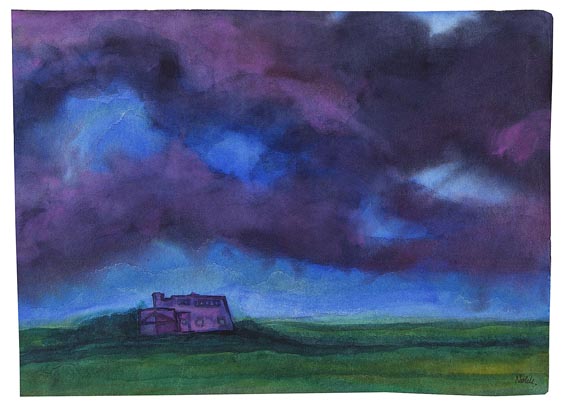
( frais d'adjudication compris)
Seebüll unter blau-violettem Himmel. Um 1940.
Our watercolour depicting the artist’s house and studio, which he designed himself, beneath a turbulent stormy sky probably dates from about 1940. “The clouds in the lofty sky are the actual actors in this flat land by the sea. Nature provided him with pictures as if on a vast stage; the overcast sky becomes an exciting scene with dramatically configured mountains of cloud [...]” (M. Urban in: E. Nolde. Landschaften. Aquarelle und Zeichnungen, Cologne 1969, p. 28). Despite the dramatic overtones of this composition, Nolde has united light and colour in complete harmony and has interwoven the various pictorial elements by means of a rhythmicised palette. Hence the colour of the reddish purple clinker building is reflected in the louring clouds, which in turn cast coloured shadows on the wide, lush green marsh landscape.
In his last years, primarily watercolours with flower and landscape motifs from the neighbourhood of his house in Seebüll, where Nolde died on 13 April 1956, emerged. [ME]
In good condition. Edges partly unevenly trimmed. With negligible crease marks due to the technique. Loosely mounted on backing.
Watercolour.
Signed lower right. On Japon. 34,8 : 48,5 cm (13,7 : 19 in), the full sheet. Emil Hansen was born near the German-Danish border on 7 August 1867. He adopted the name of his birth town as his artist name at a later date. Nolde finally moved to Munich after deciding to become a painter, but the academy under Franz von Stuck dismissed him. He joined Adolf Hölzel in Dachau in 1899 to become his pupil and went to Paris in 1900 to increase his knowledge at the Académie Julien. Nolde studied the Neo-Impressionists Vincent van Gogh, Edvard Munch and James Ensor, which, around 1905, gradually led him away from his early Romantic Naturalism and to the discovery of his own style with a strong emphasis on colour, colourful and glowing flower pictures came into existence. During a sojourn in Alsen in 1906 Nolde met the painters of 'Die Brücke', a group he joined briefly in the same year. A series of portrait studies marked the artists discovery of the watercolour. Nolde's first attempts in 1909 at painting in this technique on non-absorbent paper, leaving large areas of the paper uncovered and dispensing with contours, were quite revolutionary. After a dispute with Max Liebermann, Nolde was excluded from the 'Berliner Sezession' and founded together with other dismissed artists the 'Neue Sezession' in 1910 and participated in their exhibition until 1912. He returned from an expedition to New Guinea in 1913 with lots of study material, which he worked up in numerous works until 1915. Since 1916, he spent his summers on the island Föhr and settled in Seebüll in 1928. The garden in Seebüll became an unfailing source of inspiration for his painting, but also coast areas and religion became his primary sujets. Defamed during the war and banned from exhibiting his works since 1941, Nolde spent the years 1939 to 1945 in Seebüll painting his 'unpainted paintings', hundreds of small watercolours, which he took on in his oil paintings after 1945.
EXPERTISE: This work is accompanied by a photo expertise signed by Dr. Manfred Reuther, Stiftung Seebüll Ada und Emil Nolde, and dated 6 October 2008. The work is recorded there
PROVENIENZ: Galerie Jacques Benador, Geneva.
Private collection South Germany (since ca. 1960).
( frais d'adjudication compris)




 Lot 310
Lot 310